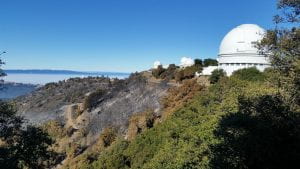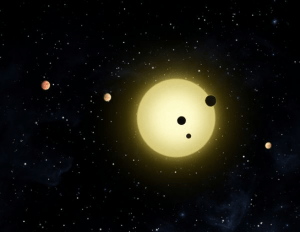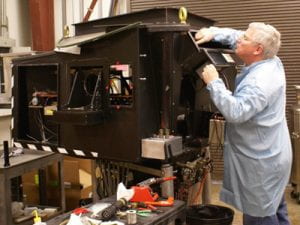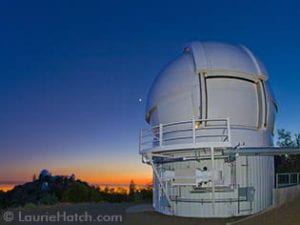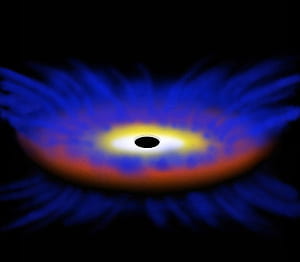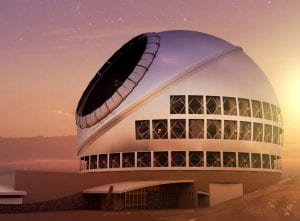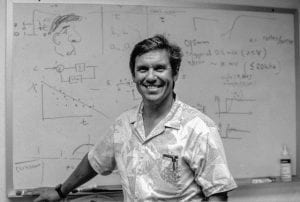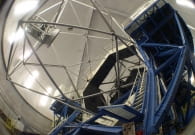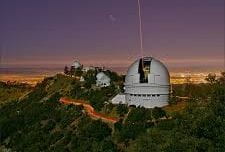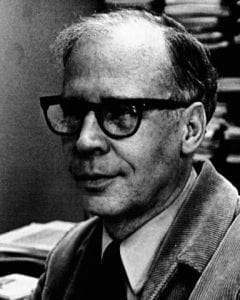Timeline
Lick Observatory as viewed from Kepler peak on Aug 27. You can see here how close the fire came. The large dome to the right houses the Shane 3-m telescope. Visible are also the Astrograph dome, the APF dome, the 36″ refractor and the Crossley domes. The fire started to head towards this direction soon after it destroyed the Barnard house at Ptolemy Peak. Firefighters were battling with the flames and keeping them away from approaching the domes.
What a great role model UCO astronomer, Andrea Ghez is, for all those young girls out there into science! Dec 9, she received her NobelPrize in Physics for her BLACK HOLE DISCOVERY. Congrats to Andrea, and her entire team. Pic credit: Annette Buhl
A team of astronomers led by UC Santa Barbara Professor Crystal Martin and graduate student Stephanie Ho released a paper investigating how these halos interact with the rest of their galaxies. As quasar light travels through these galactic halos, the dust and gas absorb specific wavelengths of light based on its composition. The research team pieced together the distribution and composition of this missing matter by comparing the light spectra from these shrouded quasars to those they can see directly.
Measurements from high-precision instruments, including Keck’s HIRES and Lick’s Automated Planet Finder, reveal a cold super-Earth around Barnard’s star.
A small team led by Ryan Foley, an assistant professor of astronomy and astrophysics at UC Santa Cruz, was the first to find the source of the gravitational waves, located in a galaxy 130 million light-years away called NGC 4993. Foley’s team captured the first images of the event with the 1-meter Swope Telescope at the Carnegie Institution’s Las Campanas Observatory in Chile.
Lick Observatory, CA
Astronomers discovered a planetary system orbiting a star only 54 light-years away with the Automated Planet Finder (APF) at Lick Observatory and ground-based telescopes in Hawaii and Arizona. The team discovered the planets by detecting a wobble of the star HD 7924. Learn More
UC Santa Cruz receives $350,000 in combined grant and donor funds to enable upgrade of the Kast Spectrograph, a crucial instrument for UC astronomers “With this award, we will be bringing the Kast up to the standards of the best observatories in the world,” said Brad Holden, a research astronomer at UC Santa Cruz and principal investigator for the Kast upgrade project. “We will be able to make observations that can currently only be done at a handful of places.”
Lick Observatory, CA
Newest telescope goes online, the Automated Planet Finder (APF), began operating robotically night after night on Mt. Hamilton in January 2014, searching nearby stars for Earth-sized planets. Its technical performance has been outstanding, making it not only the first robotic planet-finding facility but also one of the most sensitive.
Sandy Faber, a University Professor of astronomy and astrophysics at UCSC and the interim director of UC Observatories, was honored along with 11 other recipients of the National Medal of Science and 11 recipients of the National Medal of Technology and Innovation. The 2011 National Medal of Science Laureates and 2010 National Medal of Technology and Innovation Laureates receive their medals from President Obama in the East Room of The White House on February 1, 2013. Ryan K Morris/National Science & Technology Medals Foundation.
Saul Perlmutter, 52, a professor of physics at the University of California, Berkeley, and a faculty senior scientist at Lawrence Berkeley National Laboratory (LBNL), led the Supernova Cosmology Project that, in 1998, discovered that galaxies are receding from one another faster now than they were billions of years ago.
“Our findings offer a very compelling case for a potentially habitable planet,” said Steven Vogt, professor of astronomy and astrophysics at UC Santa Cruz. “The fact that we were able to detect this planet so quickly and so nearby tells us that planets like this must be really common.”
Lick Observatory will honor Kenneth and Gloria Levy as the first recipients of the James Lick Award in recognition of their generous support for the observatory’s newest telescope, the Automated Planet Finder (APF). The APF telescope will be devoted entirely to the search for planets orbiting nearby stars, with the goal of finding an Earth-like planet in another solar system.
Two planets in orbit around a mature sun-like star recently suffered a violent collision, astronomers report. “It’s as if Earth and Venus collided with each other,” said Benjamin Zuckerman, UCLA professor of physics and astronomy and a co-author on the paper. “Astronomers have never seen anything like this before. Apparently, major catastrophic collisions can take place in a fully mature planetary system.”
The Milky Way’s black hole is undoubtedly the strangest thing in our galaxy—a three-dimensional cavity in space ten times the physical size of our sun and four million times the mass, a virtual bottomless pit from which nothing escapes. Every major galaxy, it’s now believed, has a black hole at its core.
A team of astronomers from UCSC and the University of Florida discovered the onset of a huge flow of gas from a quasar, the super-bright core of an extremely remote young galaxy. The gas was expelled from the quasar and its enormous black hole sometime in the space of four years around 10 billion years ago–an extremely brief and ancient blip detectable only through the unlikely convergence of two separate observational efforts.
“This is a tremendous investment by the Gordon and Betty Moore Foundation in a path-breaking scientific tool with great potential for unlocking new insights about the nature of the universe,” said UC President Robert C. Dynes. “UC and Caltech are pleased that the Foundation has recognized the tremendous research capacity of our institutions, and we look forward to the exciting findings that this telescope will deliver in the future.”
“Professor Bolte is an ideal choice for this important position,” said Acting Chancellor Blumenthal. “With his proven administrative expertise, as well as his notable accomplishments both in observational astronomy and in the development of astronomical instrumentation, Mike will provide critical leadership for astronomers at UC Santa Cruz and throughout the UC system.”
“Adaptive optics is one of the most exciting developments in ground-based astronomy in the last decade. It is crucial to very important science being planned for existing large telescopes and absolutely essential to the next generation of giant telescopes,” said Joseph Miller, director of UC Observatories/Lick Observatory (UCO/Lick), which oversees the LAO.
A team of astronomers has announced the discovery of some of the smallest planets yet detected beyond our solar system. The two newly discovered planets represent a new class of extrasolar planets, and their discovery is a significant advance in the quest for such objects.
Thirty Meter Telescope, Hawaii
The Thirty Meter Telescope (TMT) project is initiated based on scaled up Keck telescope design with Jerry Nelson as Project Scientist. (January 15, 1944 – June 10, 2017)
Keck Observatory, Hawaii
The Keck II telescope on Mauna Kea is completed based on UCO astronomer Jerry Nelson’s designs.
Keck Observatory, Hawaii
The Keck I telescope with a 10-meter diameter primary mirror, the largest in history, is completed based on the Nelson/Mast designs.
Lick Observatory, CA
Lick developed the first laser guide-star for adaptive optics. Adaptive optics (AO) removes the blurring by the Earth’s atmosphere from astronomical images and permits ground-based telescopes to see as sharply as though in space.
Lick Observatory, CA
UC astronomers, including Steve Vogt, perfected the precision radial-velocity technique for finding extra-solar planets around other stars using the Shane telescope. With data from Lick and Keck observatories, they found hundreds of extra-solar planets, leading to the discovery that our Galaxy is teeming with extra-solar systems.
Lick Observatory, CA
Starting in the late-1980s, detailed measurements of the properties of exploding stars (supernovae) by UC astronomer Alex Filippenko were crucial to the development of methods to calibrate them. This contributed substantially to the 1998 discovery of the accelerating expansion of the Universe, probably driven by mysterious “dark energy.” Subsequent studies of supernovae, many of which were found at Lick with the Katzman Automatic Imaging Telescope, led to greater confidence in the acceleration, and this discovery was honored with the 2011 Nobel Prize in Physics.
Keck Observatory, Hawaii
Research for the Keck Observatory was led by Jerry Nelson and Terry Mast to develop segmented primary mirror designs for Keck I and Keck II.
Lick Observatory, CA
Lick developed the first digital detector, which revolutionized astronomy by replacing photographic plates.
Lick Observatory, CA
Lick achieved the first laser bounce off the Moon in 1969, measuring the distance precisely for the first time.
Lick Observatory, CA
Commissioned in 1959, this telescope was named in honor of C. Donald Shane, Lick Observatory Director during its design and construction. For many years it was the second-largest reflector in the world.
Lick Observatory, CA
In the 1950’s Lick astronomer George Herbig identified stars in the process of being born and pioneered their study.

